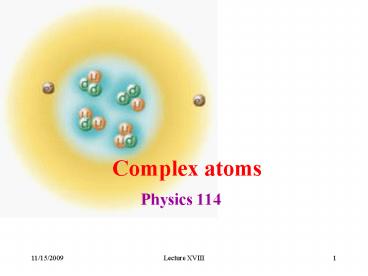Physics 114 - PowerPoint PPT Presentation
1 / 15
Title:
Physics 114
Description:
9/8/09. Lecture XVIII. 1. Physics 114. Complex atoms. 9/8/09. Lecture XVIII. 2. Announcements. Read sections 6 and 7 from chapter 28 GRR (complex atoms) ... – PowerPoint PPT presentation
Number of Views:19
Avg rating:3.0/5.0
Title: Physics 114
1
Complex atoms
- Physics 114
2
Announcements
- Read sections 6 and 7 from chapter 28 GRR
(complex atoms) - Practice tests in the library
- Lecture notes are also available in the library
- To schedule make up tests contact Ahlam Al Rawi
- 2-5520
- Ahlam_at_phys.ksu.edu
3
Concepts
- Electron distributions
- Quantum numbers, quantum state
- Pauli principle
- Periodic table
4
Particles and waves
- Massive particles (electron, proton, baseball)
- lh/p pmv
- Energy
- For electron only (KE in eV, l in nm!)
- Massless particles photons
- lc/f
- Energy
- Eghfhc/l
- If photon and electron have the same wavelength
l, their energies are different!
5
Particle in a boxWhere is the electron?
- (Amplitude of matter wave)2probability to find
particle at this place. - More chances to find the particle at a antinode
- No chance at a node
- Quantized energy stated
6
Hydrogen atom
- Energy levels in H
- n- principle quantum number determines the
energy level - What about electron distribution in atom?
7
Electron distributions
- Same n, different shapes. Other quantum numbers
play a role
- Quantum state of electron in atom is defined by a
set of 4 numbers - Principle quantum number n
- Orbital quantum number l
- Magnetic quantum number ml (same as lz)
- Spin projection ms
8
Pauli principle
- Electron has spin 1/2
- Electron is a fermion
- Not more than one electron can be in each quantum
state (Pauli principle) - Pauli principle is responsible for periodic table
(Mendeleev) - NB. If particle has an integer spin (0 or 1) it
is a boson - all particles tend to fall in the
same state. - Example photons (lasers use this principle)
9
Electron quantum state
- Principle quantum number n1,2,3,4,
- determines energy level, higher E for higher n
- Orbital quantum number l
- For each n l can be 0,1,2,3, (n-1)
- l states are leveled by letters
- s l0 p l1 d l2 f l3 gl4
- E.g. n5, then l can be 0, 1, 2, 3, 4
- Possible l states are s,p,d,f,g
- n1, only l0 s-state is possible
10
Electron quantum state
z
- Orbital quantum number is a vector length l
- Its projection on z axis is another q.n.
magnetic quantum number ml - ml can be only integer
11
Electron quantum state
z
- All electrons have spin1/2
- It is a vector
- Its projection on z axis is another q.n. spin
ms - ms can be only
12
Possible number of states
- For each given n,l,ml ? 2 possible states
- ms1/2 ms-1/2
- For each given n,l ? 2(2l1) states
- mll, (l-1), 2,1, 0, -1, -2, -(l-1), -l ?
(2l1) - For each ml ms1/2 ms-1/2 ? 2
- For each given n ? 2n2 possible states
- l0,1,2,3,4,.(n-1)
- For each l mll, (l-1), 2,1, 0, -1, -2,
-(l-1), -l ? (2l1) - For each (l,ml) ms1/2 ms-1/2
13
State leveling
- 2p3 means 3 electrons in p state (l1) at n2
level - 4f5 means 5 electrons in f state (l3) at n4
level - States filled up from lower to higher n
- For each n from lower to higher l
14
Periodic table
- Elements in increasing mass
- MANpMpNnMn
- But mass does not determine chemical properties
- Atomic number Z does. ZNp- charge of nucleus
number of electrons
- H Z1 ?1 electron
- n1, l0 (s), ml0
- 1s1
- He Z2 ?2 electrons
- n1, l0 (s), ml0
- 1s2
- 2 e spin up, spin down
- Li Z3 ?3 electrons
- 2 e on 1s shell
- 1 e on n2, l0 (s), ml0
- 1s22s1
15
Electron structure
- 2n2 states for each n
- 2(2l1) states for each n,l
- 2 states for each n,l,ml
- s(l0), p(l1), d(l2), f(l3)
- 2 states in each s subshell
- 6 states in each p subshell
- 10 states in each d subshell
- 14 states in each f subshell
- n1,2,3,4.
- l0,1,2,(n-1)
- ml-l,-1,0,1,l
- ms1/2 -1/2
- 3p4 4 electrons on
- n3, l1 subshell































